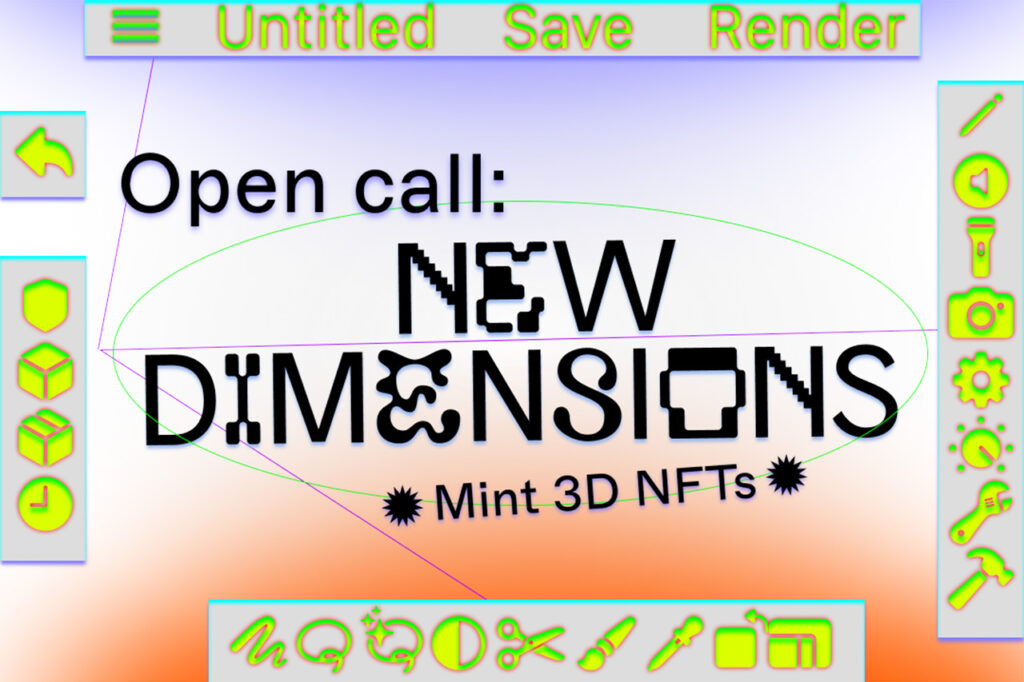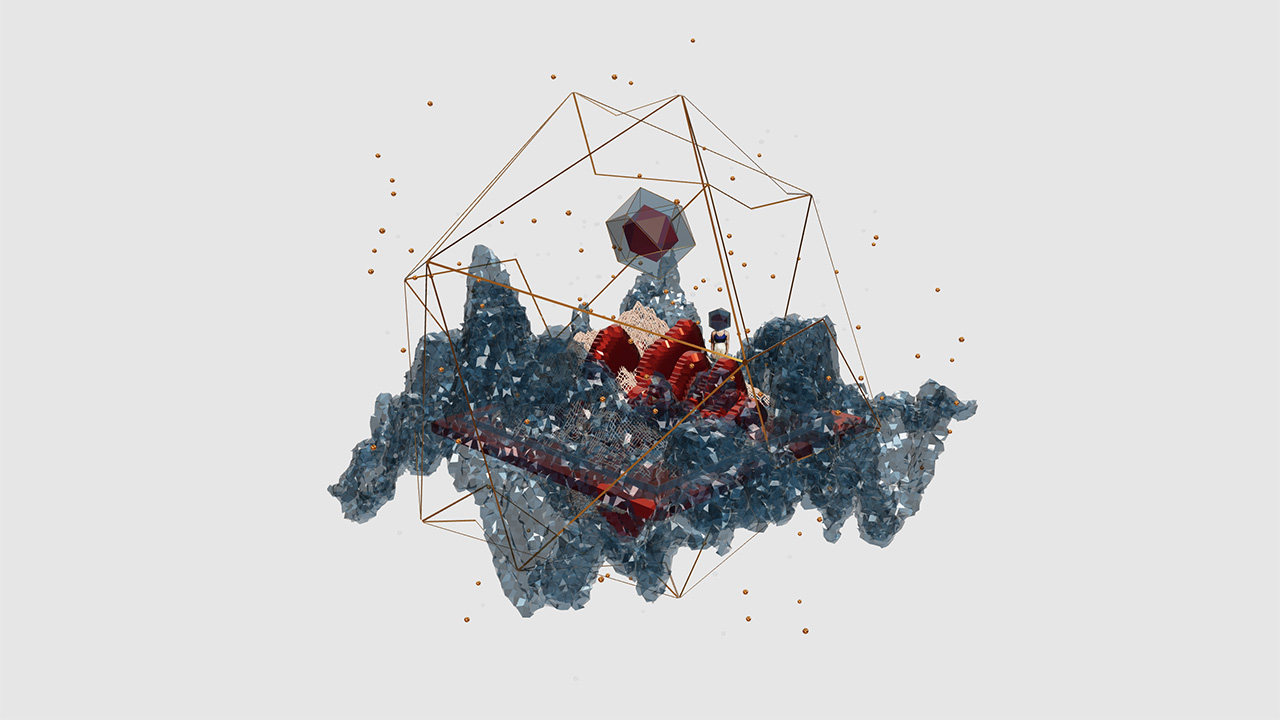Not long after its launch earlier this year, NFT marketplace Foundation introduced a new dimension (quite literally) to its crypto art playground: 3D NFTs — an emerging category of art NFTs. By affording its creators the ability to mint their NFTs in 3D, the platform is enabling these works to be viewed in the round. The hope is to greatly expand creative horizons, and reimagine how we might engage with crypto art in physical space, considering possibilities like augmented reality and 3D printing, and across the metaverse, where these pieces might reside.
“3D was always a part of our thinking,” Lindsay Howard, Foundation’s Head of Community, tells Jing Culture & Commerce. “As the next iteration of the internet unfolds, there are going to be countless currently unforeseen ways for people to interact with 3D virtual environments, and we’re anticipating that future by opening our platform to them now.”
Hence: Foundation’s currently ongoing New Dimensions open call (until September 17), which is inviting both creators and collectors to explore and experiment with 3D NFTs. Creators are encouraged to mint and list their most imaginative 3D works to be considered for the New Dimensions World showcase, while collectors are asked to propose innovative approaches to exhibiting 3D NFTs.

According to the New Dimensions open call, “experimenting with 3D NFTs is a way to imagine what’s possible as we enter a new blended reality where physical and digital dimensions coalesce.” Image: Foundation
Already, a number of standout entries have emerged from New Dimensions. Howard lists “Bufo” by Giusy Amoroso, “Autumn sunshine” by Dongsuk Lee, and “Arsia Mons” by Rory Scott among the highlights, and more so, is excited about the further conversations the open call will spark about “how we can currently experience NFTs in our day-to-day lives and what the possibilities are for the future.”
This commitment to nurturing crypto art — as a form, community, and economy — is already woven deep into Foundation’s platform and in its tools such as Splits and Worlds, which realize ways for NFTs to interact with and impact the physical world. Such, after all, is the promise of the new creative ecosystem. Here, Howard elaborates on how Foundation is laying its groundwork.
What potential does Foundation see in 3D NFTs?
[One] thing I find exciting is how 3D artworks and digital sculptures can be projected into physical space using augmented reality. You can easily interact with and scale them using a mobile device, which brings us closer to imagining how a blended IRL/virtual world can unfold.
As NFTs have exploded in popularity over the past year, what’s been the effect on the Foundation platform and community?
The growth of the NFT space in this past year has been a whirlwind. We launched in February of 2021, and in just over seven months, creators have already earned over $100 million on Foundation. While many of these creators have been working in digital media for decades, and in some cases have received significant institutional recognition, most of them have never had a clear path to generating sustainable financial support through their artwork.
Additionally, we designed our peer-to-peer invite system to expand the scope of who is using NFTs by decentralizing the curation process. Geographically speaking, and thanks to this approach, we’ve seen artists from Tokyo and Ethiopia extend invitations throughout their local networks, which has helped ensure our platform represents a wide array of creators from all across the globe. We have also seen communities come together to carve out entirely new categories in the NFT space. For example, we kicked off the meme economy with the sale of Nyan Cat for $600,000 and after that, we saw Disaster Girl, Overly Attached Girlfriend, and all kinds of other iconic memes have breakout six-figure sales.
And how has the so-called NFT boom impacted the wider crypto art economy as you see it?
People who were actively involved in building crypto’s early use case as a financial and trading tool are now becoming collectors and patrons. Many of these individuals had been acquiring crypto for years, but didn’t have anything meaningful to spend it on except for more crypto. Now, many of these investors have become passionate supporters of the creative community and are helping to establish the cultural context of crypto.

Some 3D works submitted as part of Foundation’s New Dimensions open call. Image: Foundation
Museums too are taking steps into the crypto art realm — how do you see their involvement in the space?
NFTs, and cryptocurrency more broadly, will potentially have an immense impact on museums — whether they begin accepting cryptocurrency donations or consider collecting NFTs to add to their institutional collections. On Foundation, we’ve offered curation tools through Worlds, a feature that brings together collections of artworks grouped around a particular theme. Building context in this way, much like a museum collection or wing would, is important for navigating the artists, communities, and trends that are currently unfolding across the NFT space.
For cultural institutions hoping to be involved with NFTs or work with Foundation, what are some things they should be mindful of?
One of the most powerful aspects of NFTs is how they give artists the ability to earn royalties and make passive income from their creative pursuits. What once required copious amounts of legal paperwork is now guaranteed in the smart contract automatically, meaning artists can automatically receive a percentage of the resales, or secondary market sales, of their NFTs in perpetuity.
On Foundation, we came up with Splits as a way for artists to seamlessly split earnings from NFT sales between collaborators, and donate directly to organizations they care about. Splits are also honored in secondary sales, so an organization can continue to be a beneficiary when an NFT is resold, and will receive a share of the profit each time the work changes hands. With these integrations, a lot of artists have generously chosen to donate to causes they care about as a way to give back. Foundation artist Rafaël Rozendaal recently donated 164 ETH (about $460,000 at the time) to Rhizome via his Art Blocks sale of the work “Endless Nameless” — representing the largest single donation ever made to the non-profit.
Looking ahead, how else is Foundation planning to grow its crypto art community?
As we move forward, we’re committed to aligning with our community’s values of openness, transparency, and decentralization. Helping creators succeed by collaboratively building the technology that will empower them is the only way for us to succeed too. Overall, we want to give people the tools to create a digital-first ecosystem that stands to dramatically benefit them — not just now, but long into the future.



